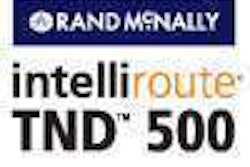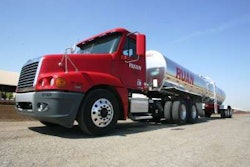After crunching your numbers, you decide to submit an aggressive bid to a shipper. The excitement from winning its business gives you confidence that the numbers will work out as planned. Soon after, reality hits. Your numbers begin to crumble when the route takes more time and mileage than planned, drivers idle their engines too much, and toll and fuel prices go up. Days and weeks pass before you realize there is even a problem.
Technology can help trucking companies avoid these and other surprises by capturing detailed records of activities that drive cost and performance. However, making intelligent decisions from all of this data often requires an additional set of tools.
Technology providers have developed applications to maximize the value of capturing so much data throughout operations. Dashboards, scorecards and other analytical tools put both historical and real-time information into context and sharpen the focus on the critical numbers that can be controlled.
Accurate pricing
Time and miles are the building blocks of most measurements used in trucking, but no two miles or hours are the same. A driver may be assigned a 300-mile route that takes the same amount of time to complete as another 150-mile route. Without understanding the unique characteristics of each route, evaluating costs and driver performance is a crapshoot.
Commercial mileage, mapping and routing software systems provide detailed information for calculating accurate cost-per-hour and cost-per-mile measures. Truckload and less-than- truckload operations traditionally have used mileages for truck routes between ZIP codes. Today’s software calculates exact mileages while considering trucking attributes for true point-to-point routing between street addresses.
Software also can consider road curvatures in its mileage calculations. Over a long-haul route, road curvatures might add between 10 and 30 miles, says Amy Krouse, director of marketing for Rand McNally, which provides the IntelliRoute software system. The latest mileage software also uses the most current information on tolls, fuel prices and other costs on a given route.
Even minor omissions in the data used to plan routes can make a big difference in cost. A Central Pennsylvania Transportation customer that requires 53-foot trailers once paid its freight bills using “practical” miles. But the customer’s version of practical miles did not factor in the differences between routing a 48-foot trailer and a 53-foot trailer. As a result, CTP’s actual miles and billable miles on the account differed by 6 percent.
CTP presented this information to the customer, who effectively agreed to increase its rate by using the mileage from a 53-foot truck route. “We’re doing more redundancy in terms of our pricing models,” says Thorny Embly, vice president of the Lancaster, Pa.-based short-haul truckload carrier. “How you break down your cost per load has an impact on how successful you are at getting business or retaining it.”
Covering fuel costs
Fuel is the most difficult cost to forecast and manage, but a fuel surcharge at least helps to recover some costs if prices suddenly rise. But indexing fuel surcharges to the U.S. Department of Energy’s weekly average diesel price won’t always cover added fuel costs on a specific route on a specific day.
Some shippers and carriers now are indexing their surcharges to daily fuel prices for a specific route. FuelSurchargeIndex.org is a service that uses actual pump prices from more than 5,000 truckstops to calculate the average daily fuel price for a point-to-point route.
“The goal of the Fuel Surcharge Index is to take fuel costs out of the equation of freight rates,” says Chris Lee, director of marketing for ProMiles Software, one of several companies involved in the venture along with Randall-Reilly, which owns CCJ. “It establishes a fair basis for the shipper and carrier to compensate for the price of fuel.”
Fleets can’t control fuel prices, but powerful reporting tools can simplify the task of managing the many different factors that drive fuel consumption. These tools help managers identify and correct specific driver behaviors in a timely manner.
AIM NationaLease provides full-service truck leasing as well as dedicated fleet operations. The Girard, Ohio-based company’s dedicated fleet, which totals about 300 trucks, uses onboard computers from Xata and several other providers. The driver scorecard of the Xatanet fleet management system shows all driver statistics and patterns for mpg, including the percentage of time a driver is in cruise control, his idling percentage, speeding and shifting patterns.
The scorecard ranks the drivers by performance for each category. “You can look at an individual driver versus the fleet,” says John Reed, vice president of information technology for AIM NationaLease. “You can make a quick assumption on what drivers to work with.”
MCO Transport uses Qualcomm’s Fuel Manager, a Web-based analytics tool, to track and manage vehicle and driver performance related to fuel use. In six months of using Fuel Manager, the 100-truck carrier’s average fuel economy has improved by about 0.5 mpg.
The ability to analyze idle time in the context of long versus short idle has been a major factor in this success. If a driver idles for a certain period of time, management assumes the driver is in the sleeper resting. “We want our trucks to idle when they need to idle,” says Randy McIntyre, vice president of fleet management for the Wilmington, N.C.-based company. “We want our drivers to get a good night’s rest for safety.” Anything more needs to be eliminated. “We can break (short idle) down to when a truck is sitting at a customer loading or unloading. We don’t want any of that.”
Putting driver and vehicle performance data into the proper context often requires integrating data between multiple systems. Pitt Ohio Express uses onboard computers from PeopleNet to capture data automatically from its vehicles’ electronic control modules (ECMs). Initially, benchmarking driver performance was a challenge for the Pittsburgh-based less-than-truckload carrier, which uses many of its 1,000 trucks for both city and line-haul operations.
The onboard computers were set up to capture data by vehicle. To capture driver and vehicle statistics (i.e. mpg, speeding, shifting and idling) by trip and to differentiate city versus linehaul, the company created its own software program to integrate its dispatch data with PeopleNet.
PeopleNet plans to provide its own application to enable the integration of metrics across various data sources. “We are working fast and furious to aggregate data with an open platform to provide cohesive reports,” says Brian McLaughlin, chief operating officer.
Information management
As fleets increase the amount of information they gather on various cost and performance factors, monitoring by exception becomes the norm. McLaughlin says that as a general rule, companies should have to manage only 5 percent of the information they gather — specifically, the items they deem most critical and addressable. “The rest is just noise,” he says.
One way to monitor driver performance across a wide spectrum of activities is to put data in the context of planned versus actual. By integrating with routing software, wireless fleet management systems automatically can track a driver’s compliance to the optimized route plan for time, miles and delivery sequence.
Trackwell ADS, an Internet-based fleet and driver management system, includes a Trackwell Route system that tracks the status of a driver’s planned route in real time. As the route progresses, the system recalculates expected arrival times for the next stops. “By getting this kind of information, and getting it live, you can service the customer better, plan routes better and measure against standards,” says Tom Lemke, chief executive officer.
CarrierMate, CarrierWeb’s platform for mobile communications and fleet management, provides an “always-on” connection between the vehicle and server. With a minute-by-minute data transfer, fleet managers can change the plan as it progresses, rather than look at information after the fact. “With an open data pipe, we are able to crunch huge volumes of data to do historical trending and give opportunities to make a decision and inform the driver,” says Norman Thomas, vice president of information consulting.
Xata’s Xatanet fleet management system tracks transit times between each stop on a route and all activities that take place at a stop, including pickup, hook, drop, delivery, etc. These measurements can be compared with a route plan or a “learned” standard for each route to evaluate driver performance, says Tom Flies, senior vice president of product planning.
Xatanet also lets users visualize the activities that take place along a route in the context of planned versus actual. On a digital map, a user can point to any position along a given route to see a driver’s transit time, fuel economy and stop time for each location. Users also can view a route with satellite imagery to see precisely when and where a driver entered a customer location.
Foodservice distributor Cheney Bros. uses information from its Cadec Mobius TTS onboard computers to manage driver and route performance throughout the day for its 300 trucks. Driver performance includes idle time, hard braking, speeding, over-rpms and unknown stops, says Phil Tippett, fleet systems manager for the Riviera Beach, Fla.-based company.
Cheney Bros. analyzes its routes in terms of planned versus actual performance; managers can see how many times a driver was delayed and for how long at a particular stop, or how many extra miles and drive time a route took. An executive-level site performance report is created monthly for each of the company’s three locations. In the past six months, Cheney Bros. has been able to reduce distance traveled by 32,335 miles while saving 3,526 hours in drive time, Tippett says.
Pinpoint geofencing
Advanced geofencing tools also help to more precisely monitor drivers’ arrivals, departures and route compliance. Geofencing is a tool used to draw an imaginary perimeter around a particular location and record when an asset enters or leaves the defined area.
Early geofencing tools were limited to using large circumferences around a location, but today other activities can be tracked. CarrierWeb lets fleets draw polygonal shapes for geofences to specify the exact location where a truck should be to record an arrival event. Users also can set up multiple geofences within a landmark. Fleets that pick up and deliver containers at a port may want to record the time a driver checks in at the gate and the time he enters the loading or unloading area, Thomas says.
TransCore launched CabLink in 2008 as an economical in-cab communications and sensor-enabled tracking and monitoring system. The company is working with several customers that use CabLink to establish a larger geofence around a location to capture the initial arrival, as well as secondary geofences to track other trigger events such as dock area arrival, says Brad Aiken, tracking and communications business development director.
With Qualcomm’s GeoServices, fleets can draw polygonal landmarks to define the edges and receive more accurate notifications regarding arrivals and departures. Polygonal landmarks can be used to set up a primary lane as a region and determine what assets are in that lane or out of route, says Jim Sasson, senior product marketing manager.
Dashboarding
To manage the sheer volume of information collected by onboard computers and mobile communications systems more efficiently, most vendors have dashboard-style reporting tools. These tools quickly spot changes in performance patterns, enabling managers to investigate root causes and view critical information that always is current and available from any computer browser.
But it may be ineffective or impossible to investigate every incident of poor performance. By using a scorecard approach to driver management, fleets can focus on drivers who are the worst offenders. J.J. Keller Mobile, a mobile resource and asset management system, provides driver scorecards with user-defined scoring parameters as part of its Web-based application.
“No matter how the parameters of the scorecard are set up, drivers are scored by a number of items that make identifying poor or dangerous drivers easy,” says Amy Daley, mobile product manager for J.J. Keller. “This scoring puts things into context, and drivers can be compared to fleet averages.”
PeopleNet recently launched an integrated dashboard reporting tool called Logistics Intelligence that is included in its Web-based interface, the PeopleNet Fleet Manager. The company plans to release a driver scorecard that will let fleets assign weights to individual factors, such as driver log warnings, fuel economy and other safety and performance measures.
In August, McLeod Software released a new Driver Scorecard module for its LoadMaster operations management system for truckload carriers. By integrating with LoadMaster’s operations, safety, fuel and mobile communications components, the application enables safety and driver managers to evaluate drivers based on user-configurable key performance indicators (KPIs) over specified time periods.
A dashboard for CarrierWeb’s CarrierMate platform takes driver management to the next level with a “what if” analysis tool. By moving a slide bar, a fleet manager can calculate the cost impact of taking certain actions based on historical and up-to-the-minute data; he could move a slide bar representing driver pay up by 3 cents per mile, and another slide bar for fuel economy up by 4 percent. The manager would know the net cost instantly, Thomas says.
Everything you do generates data. For data to be of value in a fast-moving environment such as trucking, it quickly must become knowledge so that users can respond and ultimately improve the bottom line.














